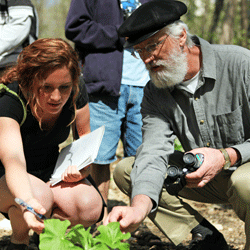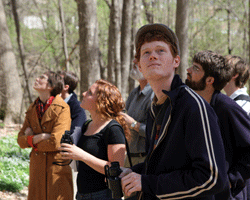You reached this page through the archive. Click here to return to the archive.
Note: This article is over a year old and information contained in it may no longer be accurate. Please use the contact information in the lower-left corner to verify any information in this article.
Student naturalists get phenological about spring
April 28, 2010
|
|
| David Mitchell '10 (front) and Rebecca Rand '10 (second from left) look for birds while leading a group of faculty, staff, and students on a mid-April tour of the college's natural lands. |
With the disappearance of the snow from Manitou Heights, migrating birds are returning to Norway Valley and the campus natural lands are awakening from their winter slumber. Since late February, student naturalists David Mitchell ’10 and Rebecca Rand ’10 have made weekly treks through St. Olaf’s natural lands to observe the various phenological events that accompany the change of seasons.
Phenology is the study of periodic biological events such as the beginnings of active and breeding seasons for animals, the leafing out and flowering of plants, and the return and departure of migratory species from a geographic area. In addition to informing basic scientific knowledge of local species and ecosystems, phenological study over long periods of time allows for the monitoring of biological changes that are responses to changes in other ecological factors.
Mitchell and Rand are expanding a project of observing these changes that has existed unofficially at St. Olaf for many years. The Biology department still maintains a phenology chart in Regents Hall on which anyone is welcome to record observations of phenological events. But because the process has never been officially standardized, with no set times or routes for observations, the data are scientifically unreliable.
Taking a hike
“We have begun regular monitoring of a set route through the natural lands, with the goal of recording phenological events as they occur this season,” explains Mitchell. “Hopefully, future student naturalists will be able to continue this study. If we collect several consecutive years of data, it may be possible to see trends over the years related to temperature, precipitation, and maybe even long-term climate change.”
 |
| Rebecca Rand '10 and College Pastor W. Bruce Benson check out the spring flora. |
In order to sample a wide variety of habitats, the weekly trek spans a significant portion of the St. Olaf grounds. Starting near the parking lot behind Regent’s Hall in Norway Valley, observers go up through the mature forest near Larson and Hilleboe, across the road to the forest behind Hoyme and Ytterboe, into the wetlands around Skoglund Pond, and north into the prairie.
“We have sighted many new critters due to the warmer spring days,” says Rand. “Chorus frogs are calling, garter snakes are active, and spring woodland wildflowers such as Dutchman's breeches, bloodroot, false rue anemone, and wild ginger are budding." She also lists migratory birds that have arrived: bluebirds, yellow-rumped warblers, red-winged blackbirds, robins, ruby-crowned kinglets, and cedar waxwings.
Mitchell and Rand generally lead walks on Friday afternoons or Saturday mornings, and the wider St. Olaf community is encouraged to participate. And usually a few knowledgeable folks participate, says Mitchell. “It's always fun to get outside, and we all learn something new about local animals and plants.”
Photos by Benjamin Hovland '11.

